Themed collection In celebration of Paul Beer’s 60th Birthday

Exploiting the dithiocarbamate ligand in metal-directed self-assembly
This Perspective examines the versatility of the dithiocarbamate ligand in metal-directed self-assembly. The ligand has been utilised to form a variety of well-defined architectures, which can participate in host–guest chemistry and in stabilising gold nanoparticles.

Dalton Trans., 2007, 1459-1472
https://doi.org/10.1039/B618088D
Halogen bonding anion recognition
The development of solution-based anion receptor molecules which exploit halogen bonding interactions is an emerging area of research. This Feature Article reviews recent advances which have been made in this rapidly developing field, surveying the use of iodoperfluoroarene, haloimidazolium and halotriazole/triazolium halogen-bond-donor motifs in anion receptor design and describing the application of mechanically interlocked rotaxane and catenane frameworks as halogen bonding anion host systems.

Chem. Commun., 2016,52, 8645-8658
https://doi.org/10.1039/C6CC03638D
Mechanically interlocked and switchable molecules at surfaces
This feature article summarises the developments made in the surface assembly and characterisation of mechanically interlocked molecules, including recent progress in exploiting templating methods to interlock molecular systems on surfaces.

Chem. Commun., 2010,46, 54-63
https://doi.org/10.1039/B915122B
Anion-templated assembly of interpenetrated and interlocked structures
The rational development of a general anion templation strategy for the construction of interpenetrated and interlocked molecular structures based upon the coupling of anion recognition with ion-pairing is described.
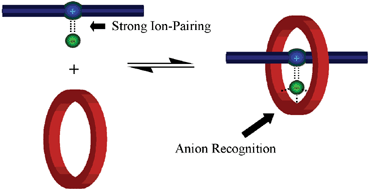
Chem. Commun., 2006, 2105-2117
https://doi.org/10.1039/B516435B
Anion recognition and redox sensing amplification by self-assembled monolayers of 1,1′-bis(alkyl-N-amido)ferrocene
Surface pre-organisation within robust amidoferrocene self-assembled monolayers can be exploited in the selective electrochemical sensing of anions in both organic and aqueous media.

Chem. Commun., 2002, 1716-1717
https://doi.org/10.1039/B205340N
Interlocked host rotaxane and catenane structures for sensing charged guest species via optical and electrochemical methodologies
Interlocked host molecules are demonstrated to exhibit high degrees of molecular recognition which, when coupled to appended reporter groups, make them highly promising candidates for the development of molecular sensors.

Org. Biomol. Chem., 2009,7, 415-424
https://doi.org/10.1039/B818351A
Metal ions in the synthesis of interlocked molecules and materials
We discuss the various roles that metal ions play, and their advantages, in the synthesis of mechanically interlocked materials.
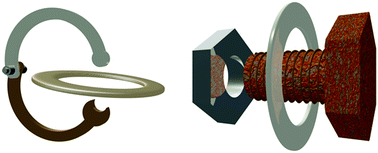
Chem. Soc. Rev., 2017,46, 2577-2591
https://doi.org/10.1039/C7CS00199A
Progress in the synthesis and exploitation of catenanes since the Millennium
Key developments including the utilization of new metal cation and anion templates, dynamic combinatorial chemistry, molecular machines and the incorporation of catenanes onto surfaces and into metal organic frameworks are reviewed.

Chem. Soc. Rev., 2014,43, 4658-4683
https://doi.org/10.1039/C4CS00029C
Meldola Medal Lecture. Redox responsive macrocyclic receptor molecules containing transition metal redox centres
Sulfate anion templation of macrocycles , capsules , interpenetrated and interlocked structures
The potential of the sulfate dianion to template the formation of complex molecular architectures including helixes, capsules, and interlocked systems is discussed.
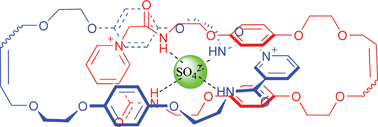
Chem. Soc. Rev., 2009,38, 1701-1713
https://doi.org/10.1039/B806041J
Anion templated assembly of mechanically interlocked structures
A new strategic anion templation methodology has been developed for the synthesis of interpenetrated pseudorotaxane, rotaxane and catenane structures, designed with a view to producing new highly selective anion receptors after template removal.

Chem. Soc. Rev., 2007,36, 211-225
https://doi.org/10.1039/B518077P
Selective perrhenate recognition in pure water by halogen bonding and hydrogen bonding alpha-cyclodextrin based receptors
Alpha-cyclodextrin based anion receptors containing halogen and hydrogen bond donor motifs display selective association of perrhenate in neutral aqueous media.
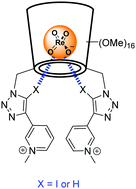
Chem. Commun., 2017,53, 3866-3869
https://doi.org/10.1039/C7CC01605K
Neutral iodotriazole foldamers as tetradentate halogen bonding anion receptors
A tetradentate halogen bond donor foldamer receptor framework is shown to exhibit enhanced anion recognition and chiral discrimination properties.

Chem. Commun., 2017,53, 2483-2486
https://doi.org/10.1039/C7CC00727B
Enhancing the enantioselective recognition and sensing of chiral anions by halogen bonding
Novel halogen bonding chiral (S)-1,1′-bi-2-naphthol-based receptor molecules significantly enhance enantioselective anion recognition and electrochemical sensing compared to their hydrogen bonding analogues.

Chem. Commun., 2016,52, 5527-5530
https://doi.org/10.1039/C6CC01701K
Halogen bonding-enhanced electrochemical halide anion sensing by redox-active ferrocene receptors
The first redox-active halogen bonding anion receptors display larger electrochemical voltammetric responses to halide binding compared to their hydrogen bonding analogues.
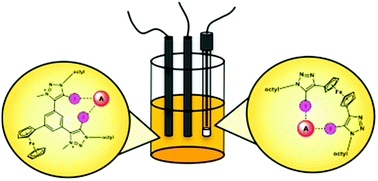
Chem. Commun., 2015,51, 14640-14643
https://doi.org/10.1039/C5CC05704C
Anion recognition in water by a rotaxane containing a secondary rim functionalised cyclodextrin stoppered axle
The synthesis of a water soluble [2]rotaxane is reported using hydrophilic secondary rim functionalised permethylated β-cyclodextrin derivatives as the axle stopper groups. The rotaxane recognises halide anions in pure water with impressive selectivity over sulfate.
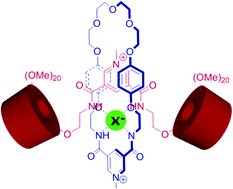
Chem. Commun., 2015,51, 4499-4502
https://doi.org/10.1039/C5CC00171D
Superior perrhenate anion recognition in water by a halogen bonding acyclic receptor
The first example of perrhenate anion binding and fluorescence sensing in water by a halogen bond donor is reported.
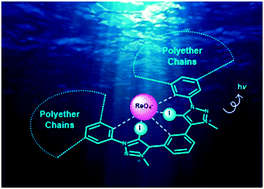
Chem. Commun., 2015,51, 3686-3688
https://doi.org/10.1039/C4CC10130H
Nitrate anion templated synthesis of a [2]catenane for nitrate recognition in organic–aqueous solvent media
The first example of a catenane synthesised using a nitrate anion template is demonstrated. The resulting interlocked host is capable of selectively recognising nitrate over a range of more basic oxoanions in a competitive organic–aqueous solvent mixture.
![Graphical abstract: Nitrate anion templated synthesis of a [2]catenane for nitrate recognition in organic–aqueous solvent media](/en/Image/Get?imageInfo.ImageType=GA&imageInfo.ImageIdentifier.ManuscriptID=C4CC03200D&imageInfo.ImageIdentifier.Year=2014)
Chem. Commun., 2014,50, 8124-8127
https://doi.org/10.1039/C4CC03200D
Neutral [2]rotaxane host systems that recognise halide anions in aqueous solvent mixtures
Four neutral [2]rotaxane host systems, synthesised via anion templation, are shown to recognise halide anions in aqueous solvent mixtures.
![Graphical abstract: Neutral [2]rotaxane host systems that recognise halide anions in aqueous solvent mixtures](/en/Image/Get?imageInfo.ImageType=GA&imageInfo.ImageIdentifier.ManuscriptID=C3CC47076H&imageInfo.ImageIdentifier.Year=2013)
Chem. Commun., 2013,49, 10793-10795
https://doi.org/10.1039/C3CC47076H
Nitrate anion templated assembly of a [2]rotaxane for selective nitrate recognition in aqueous solvent mixtures
The first nitrate templated synthesis of an interlocked structure is reported. The resulting rotaxane host selectively recognises nitrate in preference to other mono-oxoanions in aqueous solvent mixtures.
![Graphical abstract: Nitrate anion templated assembly of a [2]rotaxane for selective nitrate recognition in aqueous solvent mixtures](/en/Image/Get?imageInfo.ImageType=GA&imageInfo.ImageIdentifier.ManuscriptID=C3CC45342A&imageInfo.ImageIdentifier.Year=2013)
Chem. Commun., 2013,49, 8608-8610
https://doi.org/10.1039/C3CC45342A
Iodo-imidazolium salts: halogen bonding in crystals and anion-templated pseudorotaxanes
The 2-iodoimidazolium group is exploited in the anion-templated assembly of pseudorotaxanes with isophthalamide containing macrocycles.
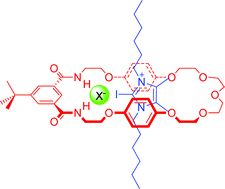
CrystEngComm, 2013,15, 3076-3081
https://doi.org/10.1039/C2CE26020D
Fluorogenic dansyl-ligated gold nanoparticles for the detection of sulfur mustard by displacement assay
The dansyl fluorophore ligated to gold nanoparticles via imidazole and amine groups affords conjugates capable of detecting micromolar concentrations of the chemical warfare agent sulfur mustard by a fluorescence switching ‘ON’ displacement assay.
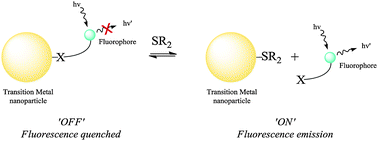
Chem. Commun., 2013,49, 2293-2295
https://doi.org/10.1039/C3CC39105A
A redox-active [3]rotaxane capable of binding and electrochemically sensing chloride and sulfate anions
A redox-active [3]rotaxane exhibits different binding and electrochemical responses to chloride and sulfate anions in competitive solvent media.
![Graphical abstract: A redox-active [3]rotaxane capable of binding and electrochemically sensing chloride and sulfate anions](/en/Image/Get?imageInfo.ImageType=GA&imageInfo.ImageIdentifier.ManuscriptID=C1CC13247D&imageInfo.ImageIdentifier.Year=2011)
Chem. Commun., 2011,47, 8775-8777
https://doi.org/10.1039/C1CC13247D
Anion induced and inhibited circumrotation of a [2]catenane
The first example of a catenane capable of performing circumrotation via an anion switching methodology is described; of particular interest is a conformational locking mechanism which results from chloride coordination in the catenane binding cavity.
![Graphical abstract: Anion induced and inhibited circumrotation of a [2]catenane](/en/Image/Get?imageInfo.ImageType=GA&imageInfo.ImageIdentifier.ManuscriptID=B719304A&imageInfo.ImageIdentifier.Year=2008)
Chem. Commun., 2008, 1281-1283
https://doi.org/10.1039/B719304A
Cooperative AND receptor for ion-pairs
A new calix[4]diquinone species has been found to bind simple ion-pair systems strongly where no discernible affinity for either of the free ions is observed.

Chem. Commun., 2006, 612-614
https://doi.org/10.1039/B515634C
Anion directed synthesis of a hydrogensulfate selective luminescent rotaxane
A new photo-active rhenium(I) bipyridyl based rotaxane has been synthesised making use of a strategy founded on anion templation. By virtue of the unique interlocked structural cavity, the rotaxane selectively senses hydrogensulfate using luminescence spectroscopy.

Chem. Commun., 2005, 1909-1911
https://doi.org/10.1039/B418878K
Indolocarbazoles: a new family of anion sensors
Simple preorganised indolo[2,3-a]carbazole derivatives are shown to recognise and sense anionic guest species using fluorescence spectroscopy.

Chem. Commun., 2005, 236-238
https://doi.org/10.1039/B412363H
Halide anion directed assembly of luminescent pseudorotaxanes
A series of new photo-active rhenium(I) bipyridyl based pseudorotaxane complexes is assembled via halide anion templation.
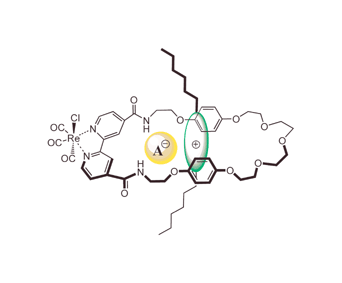
Chem. Commun., 2004, 1162-1163
https://doi.org/10.1039/B401900H
Calix[4]arene based dendrimers
The synthesis of
![Graphical abstract: Calix[4]arene based dendrimers](/en/Image/Get?imageInfo.ImageType=GA&imageInfo.ImageIdentifier.ManuscriptID=B202315F&imageInfo.ImageIdentifier.Year=2002)
Chem. Commun., 2002, 1228-1229
https://doi.org/10.1039/B202315F
The binding of difunctional neutral guest molecules by novel bis(tripyrrolyl) cryptands
Chem. Commun., 2001, 1632-1633
https://doi.org/10.1039/B104077B
Dendrimers based on multiple 1,4,7-triazacyclononane derivatives
Chem. Commun., 2000, 443-444
https://doi.org/10.1039/A909535G
Superior anion induced shuttling behaviour exhibited by a halogen bonding two station rotaxane
Two bistable halogen and hydrogen bonding-naphthalene diimide [2]rotaxanes have been prepared and the system incorporating a halogen bond donor anion recognition site is demonstrated to exhibit superior anion induced translational motion of the macrocyclic wheel component relative to the hydrogen bonding analogue.
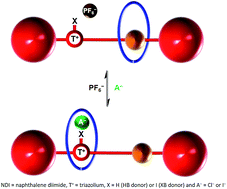
Chem. Sci., 2016,7, 5171-5180
https://doi.org/10.1039/C6SC00783J
Solution and surface-confined chloride anion templated redox-active ferrocene catenanes
The first ferrocene containing catenanes, in solution and on a surface, have been prepared by chloride anion templation.

Chem. Sci., 2012,3, 1080-1089
https://doi.org/10.1039/C2SC00909A
Cation-induced molecular motion of spring-like [2]catenanes
The synthesis and cation recognition studies of two novel heteroditopic [2]catenanes that are capable of exhibiting cation induced reversible rotary motion is described. Barium cation complexation triggers a partial intra-ring rotation of the catenanes which is reversed upon addition of sulfate.
![Graphical abstract: Cation-induced molecular motion of spring-like [2]catenanes](/en/Image/Get?imageInfo.ImageType=GA&imageInfo.ImageIdentifier.ManuscriptID=C1SC00034A&imageInfo.ImageIdentifier.Year=2011)
Chem. Sci., 2011,2, 922-927
https://doi.org/10.1039/C1SC00034A
A dual-functional tetrakis-imidazolium macrocycle for supramolecular assembly
A new versatile tetrakis-imidazolium macrocycle for use in supramolecular applications is reported. It displays excellent affinities for π-electron rich neutral guests such as 1,5-dihydroxynaphthalene derivatives and TTF, providing opportunities for the construction of interlocked molecules, as well as exhibiting extensive and potent anion coordination chemistry.
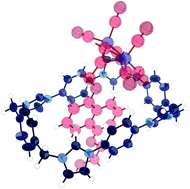
Chem. Sci., 2011,2, 494-500
https://doi.org/10.1039/C0SC00511H
Cationic all-halogen bonding rotaxanes for halide anion recognition
Faraday Discuss., 2017,203, 245-255
https://doi.org/10.1039/C7FD00077D
Copper(II)-directed synthesis of neutral heteroditopic [2]rotaxane ion-pair host systems incorporating hydrogen and halogen bonding anion binding cavities
Neutral heteroditopic [2]rotaxane ion-pair host systems were synthesised via a copper(II)-directed metal template strategy and shown to undergo cooperative anion recognition with a co-bound zinc(II) cation.
![Graphical abstract: Copper(ii)-directed synthesis of neutral heteroditopic [2]rotaxane ion-pair host systems incorporating hydrogen and halogen bonding anion binding cavities](/en/Image/Get?imageInfo.ImageType=GA&imageInfo.ImageIdentifier.ManuscriptID=C7DT02832F&imageInfo.ImageIdentifier.Year=2017)
Dalton Trans., 2017,46, 13376-13385
https://doi.org/10.1039/C7DT02832F
Tripodal halogen bonding iodo-azolium receptors for anion recognition
The preparation and anion binding properties of 1,3,5-tri-substituted benzene platform-based tripodal receptors containing halogen bonding (XB) iodo-imidazolium and iodo-triazolium motifs, and hydrogen bonding (HB) analogues are described.
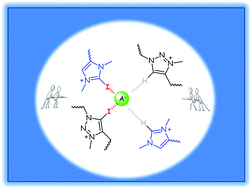
RSC Adv., 2017,7, 11253-11258
https://doi.org/10.1039/C6RA28082J
Halogen bonding rotaxanes for nitrate recognition in aqueous media
Incorporating halogen bonding into an interlocked [2]rotaxane anion host system results in unprecedented nitrate recognition in 90% water.

Org. Biomol. Chem., 2017,15, 153-159
https://doi.org/10.1039/C6OB02339H
Chelated charge assisted halogen bonding enhanced halide recognition by a pyridinium-iodotriazolium axle containing [2]rotaxane
A dicationic halogen bonding rotaxane displays enhanced binding and selectivity for bromide over other halides and nitrate and dihydrogen phosphate oxoanions in contrast to an all hydrogen bonding counterpart which is attributed to chelated charge assisted halogen bonding interactions.
![Graphical abstract: Chelated charge assisted halogen bonding enhanced halide recognition by a pyridinium-iodotriazolium axle containing [2]rotaxane](/en/Image/Get?imageInfo.ImageType=GA&imageInfo.ImageIdentifier.ManuscriptID=C6OB01851C&imageInfo.ImageIdentifier.Year=2016)
Org. Biomol. Chem., 2016,14, 10193-10200
https://doi.org/10.1039/C6OB01851C
Substituent effects on fluoride binding by lanthanide complexes of DOTA-tetraamides
Fluoride binding by lanthanide complexes of a range of DOTA tetraamides changes the magnetic anisotropy at the metal centre from an easy axis to an easy plane.
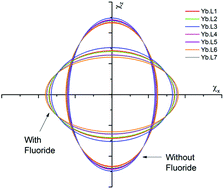
Dalton Trans., 2016,45, 3070-3077
https://doi.org/10.1039/C5DT04349B
Axial fluoride binding by lanthanide DTMA complexes alters the local crystal field, resulting in dramatic spectroscopic changes
Dramatic changes are observed in both the NMR and luminescence spectra of LnDTMA complexes on addition of fluoride, consistent with a change in the nature of the magnetic anisotropy at the paramagnetic lanthanide centre.
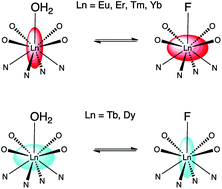
Dalton Trans., 2015,44, 19509-19517
https://doi.org/10.1039/C5DT02398J
Contrasting anion recognition behaviour exhibited by halogen and hydrogen bonding rotaxane hosts
A [2]rotaxane anion host that switches selectivity from dihydrogen phosphate to the halides upon substituting a hydrogen bond donor group for a halogen bond donor group within the axle component is described.
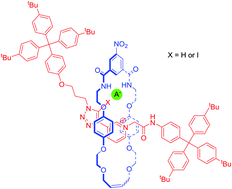
Org. Biomol. Chem., 2015,13, 2582-2587
https://doi.org/10.1039/C4OB02547D
Halogen- and hydrogen-bonding triazole-functionalised porphyrin-based receptors for anion recognition
Halogen-bonding iodotriazole anion recognition groups have been integrated into a picket-fence zinc(II)-metalloporphyrin scaffold to produce a receptor with enhanced halide anion recognition and sensing applications.
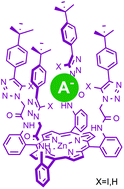
Dalton Trans., 2013,42, 15766-15773
https://doi.org/10.1039/C3DT52093E
A rotaxane host system containing integrated triazole C–H hydrogen bond donors for anion recognition
A novel bis-triazole pyridinium axle containing rotaxane, prepared by a chloride anion templated ring closing metathesis clipping strategy, exhibits selectivity for halide anions over oxoanions with a notable preference for bromide being shown amongst the halides.
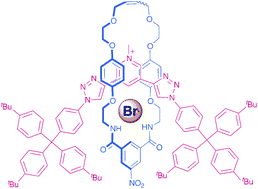
Org. Biomol. Chem., 2013,11, 1326-1333
https://doi.org/10.1039/C2OB27229F
Haloaurate and halopalladate imidazolium salts: structures, properties, and use as precursors for catalytic metal nanoparticles
We report the synthesis and structural characterisation of a series of gold- and palladium-containing imidazolium salts. The reduction of these salts can give nanoparticles stabilised either by surfactant or carbene species which demonstrate catalytic activity even while ligands are attached to the metal surface.

Dalton Trans., 2013,42, 1385-1393
https://doi.org/10.1039/C2DT31984E
Investigating the effect of macrocycle size in anion templated imidazolium-based interpenetrated and interlocked assemblies
The effect of varying the size of the macrocycle component on the formation of anion templated imidazolium interpenetrated assemblies and on the recognition properties of analogous interlocked rotaxane host systems is investigated.
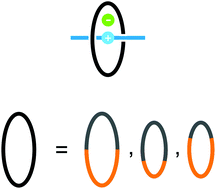
Org. Biomol. Chem., 2012,10, 7282-7291
https://doi.org/10.1039/C2OB26237A
A meta-xylenediamide macrocycle containing rotaxane anion host system constructed by a new synthetic clipping methodology
A meta-xylenediamide containing rotaxane is prepared by a novel synthetic procedure, and exhibits selective halide anion recognition.
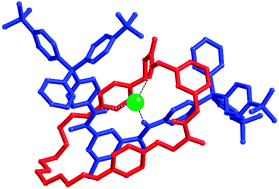
New J. Chem., 2011,35, 2047-2053
https://doi.org/10.1039/C1NJ20109C
Amplification of anion sensing by disulfide functionalized ferrocene and ferrocene -calixarene receptors adsorbed onto gold surfaces
Anion sensing by ferrocene functionalized receptors is significantly enhanced when adsorbed at gold surfaces.
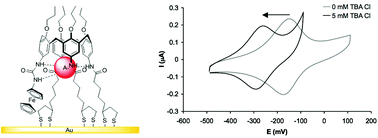
Dalton Trans., 2010,39, 6532-6541
https://doi.org/10.1039/C0DT00217H
Tuning the strength and selectivity of ion-pair recognition using heteroditopic calix[4]arene-based receptors
The fine tuning of selectivity and strength of cooperative ion-pair recognition using heteroditopic calix[4]arene-based receptors has been achieved. These modulations in binding properties are found to depend critically on the cation binding site and the macrocyclic nature of the receptors.
![Graphical abstract: Tuning the strength and selectivity of ion-pair recognition using heteroditopic calix[4]arene-based receptors](/en/Image/Get?imageInfo.ImageType=GA&imageInfo.ImageIdentifier.ManuscriptID=B615873K&imageInfo.ImageIdentifier.Year=2007)
New J. Chem., 2007,31, 684-690
https://doi.org/10.1039/B615873K
Halo-Derivatised Calix[4]tubes
Novel halo-derivatised calix[4]tubes exhibit exceptional selectivity for potassium as evidenced by NMR, ESMS and molecular modelling studies.
![Graphical abstract: Halo-Derivatised Calix[4]tubes](/en/Image/Get?imageInfo.ImageType=GA&imageInfo.ImageIdentifier.ManuscriptID=B211303A&imageInfo.ImageIdentifier.Year=2003)
Org. Biomol. Chem., 2003,1, 1232-1239
https://doi.org/10.1039/B211303A
A new carboxylate anion selective cobaltocenium calix[4]arene receptor
Solvent dependent anion selectivity exhibited by neutral ferrocenoyl receptors
Anion selective recognition and optical/electrochemical sensing by novel transition-metal receptor systems
Synthesis and X-ray crystal structure of a new redox-active calix[5]arene containing a totally included ethanol molecule
Dimer and trimer calix[4]arenes containing multiple metallocene redox-active centres. Single-crystal X-ray structure of a bis(ferrocene)-bis(p-t-butylcalix[4]-arene) hydrophobia host molecule
The synthesis and electrochemistry of novel redox responsive molybdenum complexes containing cyclic polyether cation binding sites
The synthesis of a novel Schiff base bis(crown ether) ligand containing recognition sites for alkali and transition metal guest cations
Synthesis of novel metallocene bis(crown ethers). Potassium selective intramolecular sandwich-type complexation observed by fast atom bombardment mass spectrometry
Pentaco-ordinate phosphorus compounds by nucleophilic addition to activated alkenes
About this collection
We are delighted to present this collection of 60 articles to celebrate the work of Paul Beer, on the occasion of his 60th birthday. This special collection has been organised by Chris Serpell and Phil Gale. During his research career, Paul has published more than 200 articles in Royal Society of Chemistry journals, participated in 15 themed issues, and notably published 83 times in ChemComm. This collection highlights his most recent work across a range of our journals, as well as a selection of his articles throughout his career. We would like to wish him a very happy birthday!